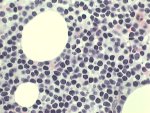 |
 |
|
Small cells with thin rim of cytoplasm |
Higher power magnification showing 'smear cell' (arrowed) |
Bone marrow trephine biopsy showing extensive infiltration by CLL cells |
 |
Atypical CLL cells showing trisomy 12, demonstrated by FISH (only visible in right-hand cells; out of focal plane in cell on left).
|
Comments & feedback to: admin@hmds.org.uk